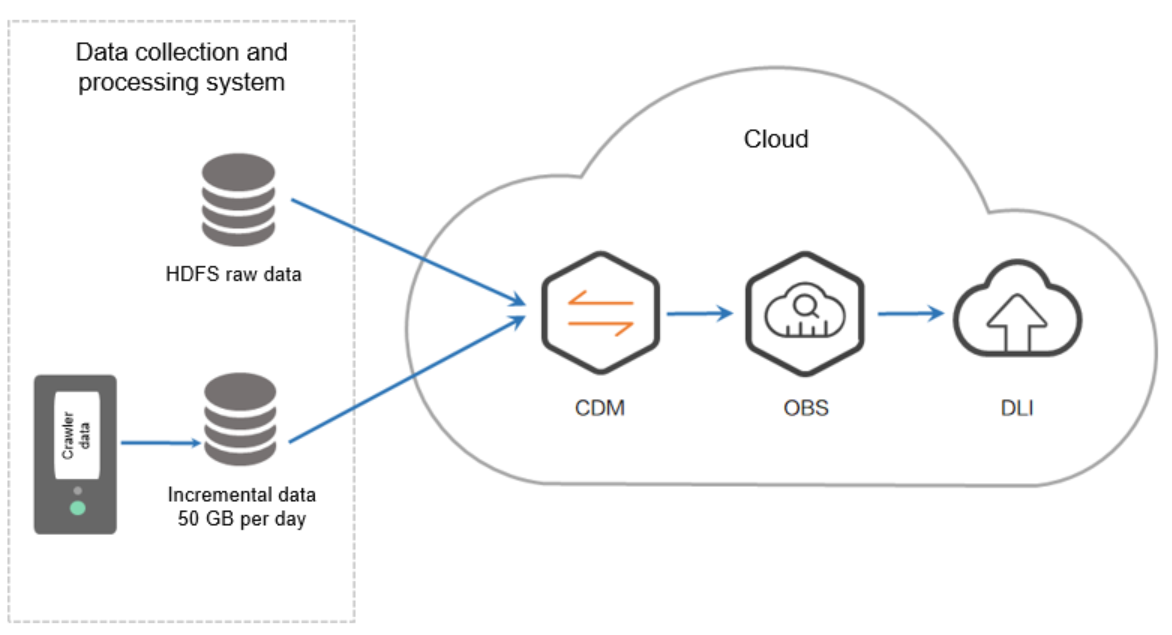Scenario
Consulting company H uses CDM to import local trade statistics to OBS, and Data Lake Insight (DLI) to analyze trade statistics. In this way, company H builds its big data analytics platform at an extremely low cost, allowing the company more time to focus on their businesses and make innovations continuously.
Background
Company H is a commercial organization in China that engages in collecting trade statistics of major trading nations and buyer data. It has a large-scale trade statistics database. The collected data is widely used in industry research, international trade promotion, and other fields.
In the past, company H used its own big data cluster with maintenance by dedicated personnel. Each year, company H purchased the dedicated bandwidth from China Telecom and China Unicom and invested heavily in equipment room, electric power, private networks, servers, and O&M. However, the company could not satisfy customers' ever-changing service requirements due to insufficient workforce and limited capabilities of its big data cluster. As a result, only 4% of 100 TB inventory data was useful.
After migrating local trade statistics to Huawei Cloud, company H can make full use of the 100 TB inventory data in maximizing asset monetization, without the need of constructing and maintaining infrastructures but relying on Huawei Cloud's big data analysis capabilities.
CDM and DLI use the pay-per-use billing mode, so maintenance personnel are not required and the dedicated bandwidth cost is reduced. Compared with the on-premises data center, CDM and DLI save the maintenance cost by 70%. In addition, CDM and DLI have low skill demands for personnel and enable smooth migration of existing services, shortening the service rollout period by 50%.
Task
Use CDM, OBS, and DLI to complete trade statistics analysis using the existing data (for example, trade detail records and basic information) of company H's customer data collection and processing system.


- When you use the DataSource syntax to create an OBS table, the ORC, Parquet, JSON, CSV, Carbon, and Avro formats are supported.
- When you use the Hive syntax to create an OBS table, the Text file, Avro, ORC, SequenceFile, RCFile, Parquet, Carbon formats are supported.
If the storage format of the raw data table does not meet the requirements, you can use CDM to import the raw data to DLI for analysis without uploading the data to OBS.
Data Types
- Trade detail records
Trade detail records include trade statistics of major trading nations.
Table 1 Trade detail records Field Name
Field Type
Field Description
hs_code
string
List of import and export offering code
country
smallint
Basic information about countries
dollar_value
double
Transaction amount
quantity
double
Transaction volume
unit
smallint
Measurement unit
b_country
smallint
Basic information about the target country
imex
smallint
Import or export
y_year
smallint
Year
m_month
smallint
Month
- Basic information
The basic information indicates the dictionary data corresponding to the fields in the trade detail records.
Table 2 Basic information about countries (description of country) Field Name
Field Type
Field Description
countryid
smallint
Country code
country_en
string
English name of a country
country_cn
string
Chinese name of a country
Table 3 Information about the update time (description of updatetime) Field Name
Field Type
Field Description
countryid
smallint
Country code
imex
smallint
Import or export
hs_len
smallint
Length of the offering code
minstartdate
string
Minimum start time
startdate
string
Start time
newdate
string
Update time
minnewdate
string
Last update time
Table 4 Information about import and export offering code (description of hs246) Field Name
Field Type
Field Description
id
bigint
ID
hs
string
Offering code
hs_cn
string
Chinese name of an offering
hs_en
string
English name of an offering
Table 5 Information about units (description of unit_general) Field Name
Field Type
Field Description
id
smallint
Measurement unit code
unit_en
string
English name of a measurement unit
unit_cn
string
Chinese name of a measurement unit
Feedback
Was this page helpful?
Provide feedbackThank you very much for your feedback. We will continue working to improve the documentation.






